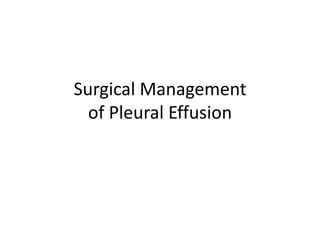
Surgical management of pleural effusion2
- 1. Surgical Management of Pleural Effusion
- 2. Thoracentesis • A procedure to remove excess fluid in the pleural space • Indications: – Diagnostic: to classify effusion as exudative or transudative – Therapeutic: palliation of dyspnea (not more than 1.5L in one sitting) • Diagnostic sampling allows the collection of liquid for microbiologic and cytologic studies
- 4. Effusion due to Heart Failure • most common cause of pleural effusion • a diagnostic thoracentesis is done if: – the effusions are not bilateral and comparable in size – the patient is febrile – the patient has pleuritic chest pain to verify that the effusion is transudative • Otherwise the patient's heart failure is treated • If the effusion persists despite therapy, a diagnostic thoracentesis should be done • A pleural fluid N-terminal pro-brain natriuretic peptide (NT-proBNP) >1500 pg/mL is diagnostic of an effusion secondary to congestive heart failure
- 5. Parapneumonic Effusions • most common cause of exudative pleural effusion (bacterial pneumonias, lung abscess, bronchiectasis) • The presence of free pleural fluid can be demonstrated with a lateral decubitus radiograph, CT of the chest, or ultrasound • If the free fluid separates the lung from the chest wall by >10 mm, a therapeutic thoracentesis should be performed • A procedure more invasive than thoracentesis is needed if the following factors are present: – Loculated pleural fluid – Pleural fluid pH <7.20 – Pleural fluid glucose <3.3 mmol/L (<60 mg/dL) – Positive Gram stain or culture of the pleural fluid – Presence of gross pus in the pleural space
- 6. Parapneumonic Effusion • If the fluid recurs after the initial therapeutic thoracentesis and if any of these characteristics are present - a repeat thoracentesis • If the fluid cannot be completely removed with the therapeutic thoracentesis, – insert a chest tube and instill a fibrinolytic agent (e.g., tissue plasminogen activator, 10 mg) – perform a thoracoscopy with the breakdown of adhesions – Decortication (if these measures are ineffective)
- 7. Malignant Pleural Effusions • 2nd most common type of exudative pleural effusion (lung carcinoma, breast carcinoma, & lymphoma) • Diagnosis: cytology of the pleural fluid • If cytology is negative, thoracoscopy is done if malignancy is suspected • Pleural abrasion should be performed to effect a pleurodesis • Pleural abrasion: a scourer is used to scrape off the surface of parietal pleura • An alternative to thoracoscopy : CT- or ultrasound-guided needle biopsy of pleural thickening or nodules • Patients with a malignant pleural effusion are treated symptomatically • Dyspnea if present and is relieved with a therapeutic thoracentesis, one of the following procedures should be considered: – insertion of a small indwelling catheter or – tube thoracostomy with the instillation of a sclerosing agent such as doxycycline, 500 mg
- 8. Chylothorax • Occurs when thoracic duct is disrupted and chyle accumulates in the pleural space. • Causes: trauma (thoracic surgery), mediastinal tumors • Thoracentesis shows milky fluid, and biochemical analysis reveals a triglyceride level that exceeds 1.2 mmol/L (110 mg/dL) • Treatment: insertion of a chest tube plus the administration of octreotide • If these measures fail, a pleuroperitoneal shunt should be placed • An alternative treatment is ligation of the thoracic duct
- 9. Hemothorax • Diagnostic thoracentesis shows bloody pleural fluid, • Hematocrit :if >1/2 of that in the peripheral blood, the patient is considered to have a hemothorax • Causes: trauma, rupture of a blood vessel or tumor • Treatment: tube thoracostomy ( helps quantify bleeding) • If the bleeding emanates from a laceration of the pleura, apposition of the two pleural surfaces is likely to stop the bleeding. • If the pleural hemorrhage exceeds 200 mL/h, perform thoracoscopy or thoracotomy
